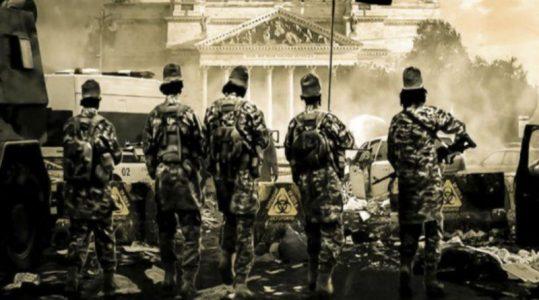
New ISIS terror threats include biological and radiological warnings
Threat images distributed by ISIS-supporting media groups in their regular campaign of recruitment and incitement materials have in recent days included suggestions of radiological and biological attacks.
Al-Taqwa Media Foundation distributed an image depicting a capitol building — not the U.S. Capitol – in flames with a calamitous street scene including abandoned military vehicles and civilian cars, as the ISIS flag is raised and a quintet of armed, camouflage-clad jihadists stand before the building. In the image are four biohazard warning symbols: one on a nearby building, and three on concrete barricades separating the jihadists from their target.
“O Crusaders, you have realized the danger of the Islamic State. But you did not know the treatment, and you will not know the treatment, because there is no treatment!” reads the text. “By fighting it, it gets stronger, and by leaving it, it blooms and stretches more.”
“While Trump promised defeat of the Islamic State, Obama has lied before and our Lord — the Almighty — promised victory, and here we are,” the group continued. “… This campaign is your last campaign, and it will fail by the permission of Allah. As all your campaigns have been broken before and failed, but this time we are going to invade you, and you will never invade us ever.”
An image circulated soon afterward by another ISIS-supporting group depicted a desolate rural home with a torn-up roof and crows circling overhead. In the image are three radiological warning symbols, one on a signpost and two at the home. Below the warning symbol on the signpost reads “Just Terror” — ISIS lingo for lone jihad.
“We will soon do this,” reads the only other text on the poster, in all-caps.
Following that, the Ash-Shaff Media Foundation circulated online a poster depicting a knife blade inserted into a loaf of French bread, adding to the “kuffar,” or disbelievers, that “we will slaughter you and we will terrorize you in a way that you did not expect!” On the edge of the poster are icons of twin rifles, saws, axes and knives.
Material issued by the ISIS-backing network of online supporters several weeks before the Nov. 9 Bourke Street rampage in Melbourne, in which a restaurateur was stabbed to death, encouraged jihadists to concentrate on poisoning Australia’s food supplies.
At the height of Australia’s strawberry contamination crisis in September — when more than 100 reports of needles found inserted into the berries resulted in growers disposing of their crops — some theorized a disgruntled employee at a packing house may have been responsible, but the case is still open.
ISIS never claimed responsibility for poking needles into the strawberries, but late that month jihadists seized upon the crisis to encourage bioterror.
“O Crusaders! We will never allow you to enjoy the taste of what you desire,” said one poster distributed by ISIS supporters, including a drawing of a small bottle of poison and a photo of a fruit bowl containing grapes, apples and oranges.
Another poster with the same message bore the word “Australia” with a photo of a man in a T-shirt clutching his stomach.
“O Crusaders, We will make you check everything and anything you eat out of fear, horror and terror,” said another image of strawberries, a bottle marked “poison,” and a photo of the Sydney Opera House.
In July, Al-Faqir, a prolific ISIS media group that recently threatened grenade attacks at music venues, released a video titled “Bio Terror” that walked supporters through how to wage a bioattack on the West “that cannot be detected or tracked.”
“Sprinkle the liquid substances or the basics of bacteria with drinking water to take effect automatically,” the video advised would-be jihadists. “Sprinkle the crushed material on exposed fruit and public foods or scatter them in the air in crowded places — with caution.”
An ISIS guide that began online circulation in fall 2016 directed lone jihadists to construct explosives from “simple things” like rat poison and use poisonous plants to inflict casualties, such as the castor seeds that harbor ricin. The guide underscored that children especially have “weak resistance” to the naturally occurring poison and discussed extraction methods once the jihadists are able to obtain seeds.
That guide also discussed extraction techniques for the Strychnos nux-vomica, or strychnine tree. It told jihadists that “even 1% of the killer in a glass of water” can be detected due to strychnine’s bitter taste, but lauded it as “one of the most brutal kinds of poison.”
Source: PJM





